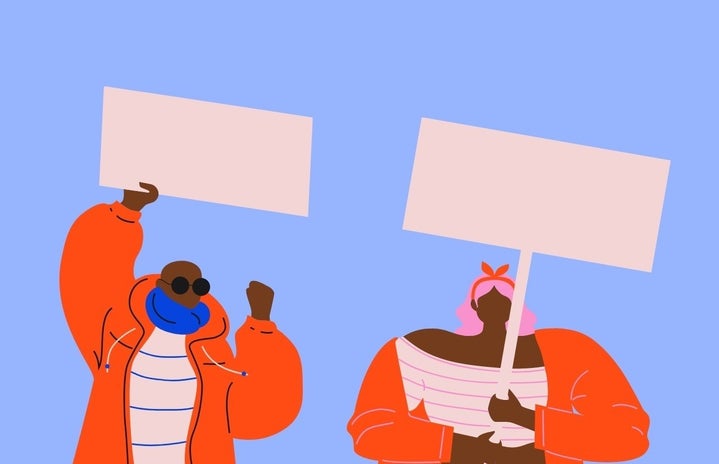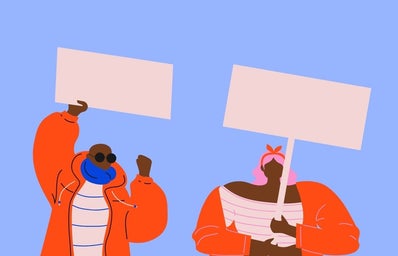Feminism means a lot of things to a lot of different people. For some people, it means debunking the idea that “girly” is an insult, for others, it means taking down the beauty standards for women in the media. Besides these surface-level ideas, feminism is supposed to mean belief in equality between sexes. But, currently, the idea of feminism in mainstream American culture is a white one.
White feminism. What does that mean? To my understanding (although I am a white woman in a privileged position who is still working to dismantle and rebuild my own viewpoints), white feminism is feminism that only applies to white women, specifically those with the financial means to achieve individual, capitalist goals that benefit them specifically. The idea of being a “girlboss,” breaking the glass ceiling, or being a “nasty woman” all are examples of white feminism.
A white feminist may achieve her goals of being a CEO or becoming a political figurehead, but her success will not apply or support the women economically below her. In fact, her success in our current political/economic/social system will do nothing for other women but keep them in the current positions of suffering and discrimination.
A white feminist’s (not that all white women fall under this feminism) idea of feminism is not very far-reaching, either. They do not look deeper than their own individual ascents besides other white women’s corporate successes. As said by Author Koa Beck, “White feminism is a specific way of viewing gender equality that is anchored in the accumulation of individual power rather than redistribution of it.” I’ve seen examples of this in my own life, and if you’re a white woman, you definitely have as well. My junior year of high school, a bunch of white teenage girls I went to school with, who identified as both liberal and feminist, gathered to take a picture with a certain Republican politician notorious for cutting taxes for the wealthy, supporting Donald Trump, and decreasing public access to public childcare and healthcare.
These are all inherently anti-feminist policies. He is an anti-feminist politician. Yet, these white women who call themselves feminists posed with him because he was famous, and because he had connections on Capitol Hill. Besides, his policies were never going to hurt them specifically, so who cared?
If you’re a white woman like I am, the need to understand the concept of intersectional feminism is incredibly crucial to begin to fight against white feminism. Intersectional feminism, first defined by law professor Kimberlé Crenshaw (who is amazing, by the way – see her discuss the issue below), is “a prism for seeing the way in which various forms of inequality often operate together and exacerbate each other.” Meaning, all inequality is not created equally. Yes, white women can experience sexism and harassment in their lives. At the same time, black men experience racism and systemic inequalities. However, a black woman experiences both of these forms of inequality, and they overlap in a way that is frankly never considered by the average white woman. At all.
If you do some research (I recommend looking here as a starting point), you’ll also learn that to have an intersectional lens, you need to recognize the historical injustices white women have committed against women of color, specifically black women. Here are a couple of times white women have left black women behind in pursuit of individual feminism:
Missionaries (AD 500-Present)
Missionaries often seek to promote certain religious values in countries abroad and is an understated form of both imperialism and colonization that white women have been at the forefront of for centuries. Although many think that missionary work is doing good, it can be extremely harmful–as said by Mark Plotkin, president of the Amazon Conservation Team, “Nobody should play God.”
These white women (as three out of four missionaries are currently white women and the numbers were similar in historical missions) were and are fully imposing their own culture and religion on cultures who didn’t ask to be imposed upon, while grabbing power from them in the form of white supremacy and disease (as white people brought smallpox to the indigenous people of North America, and current missionaries have exposed multiple indigenous tribes abroad to COVID-19). The harmfulness of missions, both historical and contemporary, can be summed up with a quote from Kenyan activist Jomo Kenyatta:
“When the Missionaries arrived, the Africans had the land and the Missionaries had the Bible. They taught us how to pray with our eyes closed. When we opened them, they had the land and we had the Bible.”
The Woman’s Suffrage Movement (1846-1920)
The United States Women’s Suffrage Movement is often described as a group of progressive women fighting for their right for all women to vote. Although initially inclusive of both black and white women, after the 15th amendment passed after the Civil War and women were not included in the expansion of voting rights to black men, the leaders of the women’s suffrage movement let their racism and elitism take hold for the rest of the movement. Leaders such as Elizabeth Cady Stanton and Susan B. Anthony shifted the focus of the movement towards only white women.
The way so many white women supported black suffrage until realizing it may not directly benefit them is a classic example of how harmful white feminism can be. It also shows how white women may pretend to care about social issues that don’t directly affect them, but many truly only are feminists for women like themselves, in a system built for themselves.
The 2016 Election
According to an analysis by Pew Research Center, 47% of white women who voted in the 2016 election voted for Donald Trump, compared to 45% who voted for Hilary Clinton. In our winner-take-all electoral system, that means that white women mattered a significant amount in Donald Trump’s victory.
In fact, white women have consistently voted for conservative candidates since 1952. If this shocks you, it shouldn’t. In order to maintain their status in the racial hierarchy currently in the United States, many white women accept the blatant sexism against them from candidates, not to mention the racism and sexism against women of color.
White women thus receive far too much credit for being progressive, and that is why white feminism is the mainstream type of feminism in the United States today. So, as white women, we need to understand why we are both a strong force, and a dangerous one when it comes to political power, and how we can start using that for good instead of evil. Frances Ellen Watkins Harper once said, “If there is any class of people who need to be lifted out of their airy nothings and selfishness, it is the white women of America.” So, let’s help lift ourselves.



